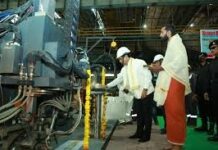–Prof. Dr. P. K. Jena
(Former Director General, Council of Scientific & Industrial Research, India)
Chairman
Email: prof.pkjena_iates@yahoo.com
The human beings on this planet particularly during the last century, have made spectacular advancements in science and technology. This has resulted in rapid growth of various types of industries in different parts of the world utilizing the natural resources in order to meet the growing requirements of different essential materials and entertaining items. As a result, the mining of minerals and development of various types of industries including integrated iron and steel plants, aluminium and other non ferrous metals industries, cement and refractory industries, thermal power plants, oil refineries, chemicals and paint production units, automobiles & tractors industries etc., have come up in large numbers in different parts of the world. But in these industrial sectors, the amount of various types of wastes particularly, the hazardous ones generated, are enormous and growing rapidly resulting in a lot of harm to the people working in the industries as well as to the environment in the areas including plants, animals and human beings. As a result, benefits derived by the human beings from these industries are getting very much annulled by their harmful effects. Some of the hazardous wastes include millions tones of red mud produced during production of alumina from bauxite, similar amounts of fly ash generated during harnessing power in thermal power plants, enormous quantities of toxic slags, leached residues, flu dusts, hazardous liquid and gaseous effluents containing oxides of nitrogen, carbon and sulphur from different metallurgical, chemical and cement industries. In addition to these, wastes of many toxic chemicals, electrical and electronic equipment wastes containing heavy metals like mercury, lead, zinc and cadmium and also other materials like pesticides, dyes, cyanides etc used by human beings for different purposes are being generated in large quantities. These are highly hazardous in nature and are responsible for creating various types of environmental pollution and disasters. For example, the highly toxic Methyl Isocyanate gas leakage in huge quantity from Union Carbide factory at Bhopal, India, in 1984 and Chernobyl atomic reactor accident in USSR, which caused a lot of devastation to the human beings as well as to the environment are still fresh in our memory. The enormous poisonous gases generated in such accidents in different industries induce appreciable depletion of ozone layer, create ozone holes, Green House effect, global warming and acid rain killing millions of living organisms along with human beings and result in great disturbances to the natural ecosystem.
Causes of Industrial Pollution
Industrial pollution is caused due to careless handling of raw materials and the products and release of solid wastes and effluents to the environment without proper treatment. In many developing countries including India, due to the fact that, the owners of most of the mines and industries give more importance to produce more with minimum cost, very little attention is paid to control the pollution. Industrial pollution not only affect the people working in the industries or the mines but also contaminate the environment through release of toxic wastes affecting the water bodies, drinking water, the air and also reduce the quality of soil. Some of the causes of industrial pollution are:
- Lack of effective policies and their proper implementation,
- Unplanned industrial growth,
- Adopting outdated technologies,
- Presence of environmentally uncontrolled large number of small scale industries like tannerys, electro plating and e-waste processing units, and
- Unscientific processes used for solid wastes and effluents disposal
Effects of Industrial Pollution-
The industrial pollution is not only confined to the industries or the mines but its adverse effects are very much felt in the surrounding areas. The environment in the industrial areas is affected through pollution of water, air and land causing a lot of harm to the plants, animals and human beings.
The water pollution by the industrial wastes and effluents is caused due to contamination of heavy metals, harmful chemicals, organic wastes and radioactive wastes. The water polluted for a long period causes serious impact on the health of our eco-system. Such polluted water used by the people in the area not only causes various types of diseases but also affects the quality of food that is produced on the land using such polluted water for irrigation. Similarly, other animals are affected by consuming such polluted water
Soil pollution due to the wastes and effluents of the industries is creating problems in agriculture, destroy local vegetation and affect the health of animals. It also causes chronic health issues to the people that come in contact with such soil on a daily basis.
Similarly, the air pollution by the toxic gases affects the people in the area with deadly diseases like asthma, cancer etc. All types of pollution also affects the forest areas as well as the wildlife. In recent years, because of the release of green house gases in large quantity by various industries, the global warming is taking place and is being manifestated in the form of melting glaciers, extinction of polar bears, floods, tsunamis, hurricanes etc.
Inside the industry, many of the workers because of lack of proper facilities and training are exposed to various pollutants which cause a lot of diseases. Some of the occupational diseases are dermatitis (inflammation of the skin), anthrax (due to bacillus), pneumoconiosis (due to dust retaining in the lungs), silicosis (inhalation of silicadust), asbestosis (asbestos fibres affecting lungs), byssinosis (inhaling air containing cotton dust), bagassosis (inhaling bagas dust), heavy metal poisoning (causing fatigue, loss of apitite, abdominal pain etc), occupational cancer etc.
Industrial Pollution Control-
In view of various hazards involved in the industrial pollution, it is essential to control the pollution, so that the man, material, machinery and the environment in general are protected and maintained properly. The most important measure in this regard should be based on the principle of recovery of values from the wastes so that, the wastes are considered as byproducts. Some of the important steps in this regard are control of the waste at the source through alternation in the choice of raw materials, and the proper choice of the process to be used for treatment of the solid wastes as well as gaseous and liquid effluents before discharging to the environment. In addition to these, the selection of industrial site should be properly examined considering the climatic and topographical characteristics. Necessary steps should be taken for protecting the environment through intensive plantation in the region and taking necessary measures to suppress the dust, smoke as well as other gaseous pollutants. It is also necessary to make time to time assessment of the impact on the environment and take necessary steps to mitigate those.
Occupational Health Hazards-
The occupational health hazards have to be identified and necessary steps should be taken in the industrial sites and the surroundings to control these. Some of these are given below:
- Air Contaminants:These include dust, fumes, mists, aerosols, and fibres.
- Chemical Hazards:These are various toxic chemical compounds in the form of solids, liquids and gases.
- Biological Hazards:These include viruses, bacteria, fungi and other living organisms which cause acute and chronic infection to the people in and around.
- Physical Hazards:These include excessive levels of ionizing and non-ionising electro-magnetic radiation, noise, vibration, illumination, and temperature.
Pollution Prevention-
It is said “prevention is better than cure”. Therefore in any industry the pollution prevention should be planned in the very beginning so that while keeping the environment clean it can be possible to improve the efficiency of workers in the industry causing better productivity and naturally increasing the profit and giving various benefits to the workers. The following measures can prevent pollution to a great extent.
- It is necessary to take proper steps for improving the production process,
- Taking inventory of equipments and housekeeping for improving the production process.
- Evaluate options for eliminating use of hazardous materials in the production process.
- To examine the possibility for recycling the wastes in the process,
- The replacement of older equipments by more sophisticated ones.
- Handling of chemicals in more scientific way to prevent and control of spills.
- Keeping the hazardous wastes separate from non-hazardous ones so that, it would be less expensive to process or dispose the hazardous wastes.
- Incorporating a preventive maintenance programme in daily basis.
General Methods for Management of Hazardous Wastes-
The hazardous wastes being highly detrimental to the environment and other living beings on this planet and their increasing generation with rapid industrialization, it has been essential to develop necessary technology to minimize and manage the hazardous wastes. The processing can be carried out broadly in three different ways namely:
- Waste Reduction Alternatives
- Hazard Reduction Alternatives and
- Safe disposal of hazardous wastes.
- Waste Reduction Alternatives
As regards the waste reduction, four important measures are practiced, and these are,
- Segregation at the source,
- Process Modification,
- End Product Substitution and
- Materials Recovery and recycling
1. Segregation at the Source
This is the simplest and least costly method for reduction of the amount of hazardous wastes. In this process, in the concerned industry level, the hazardous material is separated from rest of the wastes, making it easier for handling and also to manage the hazardous waste from economic point of view. For example, in metal finishing rinse water, the hazardous toxic metals are separated from the rest by some chemical process so that, the water free from the hazardous element can be disposed through industrial sewage system after very simple processing.
2. Process Modification
In this case, various modifications are tried to improve the process keeping an eye in generating minimum amount of hazardous wastes. For example, in the chloro- alkali industry that produces chlorine and caustic soda, it is possible to reduce major hazardous wastes by bringing some modification in the mercury electrolysis cell. The modifications though aimed at increasing the process efficiency and reduce the production cost, but it also reduces the hazardous wastes.
3.End product substitution
In this end product substitution, the objective is the replacement of a product which produces hazardous waste by another which minimizes or completely eliminate the hazardous waste generation. For example, by replacing asbestos pipe by a suitable fire clay pipe, it may be possible to minimize hazardous waste generation. However, we have to keep in mind to choose the replacement from performance and durability points of view. Therefore, development of a substitute has to be made with some advantages either to the user or to the manufacturer or to both.
4. Materials Recovery and Recycling
Recovery of hazardous material in the production chain followed by recycling it in the industry or recovering some values from it could help the industry to cut down the expenditure for managing the hazardous wastes as well as improving the economics of the process. For example, hazardous inorganic salt can be concentrated from aqueous streams by evaporation or an organic liquid can be separated by distillation. Similarly, hazardous waste in solid form can be separated from aqueous solution through precipitation. For example, heavy metals present in aqueous solution can be recovered as its hydroxides from metal plating waste sludge followed by electrolysis.
- Hazard Reduction Alternatives
The technologies that reduce the hazards of the wastes should be applied as an alternative measure. These include the treatment of the hazardous waste and removing the hazardous elements from the rest of the waste which can be safely disposed. This is more preferable and free from risks to human health and the environment than the disposal of the original waste on the land or in the sea. Because in direct disposition in the land, a part of the hazardous waste can be released due to weathering or through leaking thus affect the land and water bodies.
The treatments of hazardous wastes by removing the hazardous element from rest of the waste are principally of three types.
- Incineration and other thermal destruction.
- High temperature decomposition and
- Chemical stabilization.
1. Incineration and other thermal destruction
Incineration is a favourite technology which is used to decompose hazardous wastes. In this process, the hazardous character is destroyed. Various engineering data including the design of incinerating unit is available. In this process, only the air is somewhat get polluted. Most of the high toxic, organics are destroyed during this incineration process. It is a medium to high cost process. It is possible to recover some energy and also some other materials.
2.High temperature decomposition
High temperature decomposition is a very effective process for decompositing all types of hazardous wastes. Many commercial units are based on such process. It is a medium to high cost process. However, it is possible to recover energy and some metal values in this process.
3. Chemical Stabilization
The chemical stabilization process is also quite effective to treat hazardous wastes. Some suitable chemicals are used to stabilize the hazardous component of the waste. In this process, the environment is not very much affected. It is not so costly and the product sometimes can be used.
- The disposal technique for hazardous waste
Landfill and impoundment is the most important process used for disposal of hazardous wastes. Land filling is the burial of waste in excavated trenches or cells. The waste may be in bulk form or containerized. The operation and construction of these more advanced landfills have been evolutionary processes and are ongoing. The objective of land filling is to reduce the frequency of occurrence of release of hazardous substances so that the rate of release do not pollute water or air resources. The advance design to reduce the hazardous material contaminating the soil and water bodies should have effective components such as (i) Bottom Liners, (ii) Leachate collection and recovery system and (iii) the Cover
- Bottom liners
The function of a liner placed beneath a landfill is to reduce the migration of leachate from the landfill so that it can be collected and removed. All liner materials are subjected to breaches in their physical integrity. These failures can be a more important factor in increasing the rate at which liquids can migrate than the inherent conductivity of the liner.
- Leachate collection system
Leachate collection systems are a series of perforated drainage pipes buried up to the lowest points within a landfill. These pipes are designed to collect liquids which flow under the influence of gravity to the lowest points. Time to time the leachate is pumped out to the surface. If the liquid is found to be still hazardous, it should be treated to destroy the hazard character and then discharged.
- The Cover
After the land fill is completed, the final cover is installed. The function of the final cover is to reduce the infiltration of water from outside and to provide a physical barrier over the waste. Therefore, it should be dome type. It must also remain structurally sound over time.
Human beings in the present world have been greatly successful in utilizing natural resources to meet their various requirements with the help of science and technology. In this process, a large number of industries have come up in different sectors. But, very often the carelessness and unscientific methods used to treat and dispose the hazardous wastes generated in these industries, have resulted in a lot of pollution which harms the people working in the industries as well as to the environment in the areas including human beings, plants and animals. In order to get the best out of these industries for a healthy and happy living, human beings have to mitigate and prevent the harmful effects of the hazardous wastes generated. In order to provide better working condition to the people working in the industries and to protect the environment, it is essential to properly manage the hazardous wastes in a scientific manner through waste reduction at the source, hazard reduction and their safe disposal. The merits of the processes of Hazardous waste management should be considered from points of view like (i) Effectiveness (ii) Reliability (iii) Environmental media most affected (iv) Least compatible waste (v) Costs and (vi) Resource recovery.











































